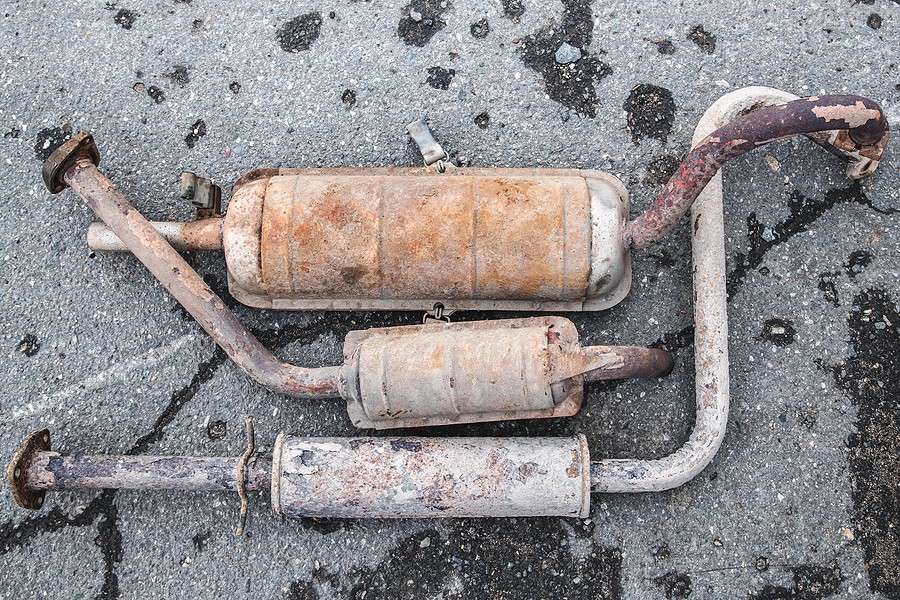Your car produces a lot of poisonous gases that could potentially be bad for the environment when you’re driving it around. But fortunately, it has an emissions system in it that’s specifically designed to limit the poisonous gases that are able to work their way out of your car and into the atmosphere. By doing this, the emissions system in your car is able to make your car better for the environment. However, you may have to deal with an emissions system problem at some point in time that will result in your car allowing more poisonous gases than you would like out into the world. It’ll be up to you to fix this problem sooner rather than later. Learn how to identify emissions system problems and find out how to fix them below.
What Is an Emissions System?
First things first: Before we begin talking about all the different emissions system problems that you might face if your system ever stops working on you, let’s make sure that you know what an emissions system problem actually is. This system plays a very important role in the overall well-being of your car, even though it might not be something that you think about a whole lot.
When your car is turning on, it tends to produce a handful of poisonous gases. These gases include things like oxide of nitrogen (NOx), carbon monoxide (CO), hydrocarbons (HC), and more. If your car didn’t have an emissions system in place, these gases would be free to exit out the back of your vehicle where they could then escape and do damage to people, animals, plants, and the environment as a whole. It’s what makes this system so essential.
Your emissions system, when it’s working the way it’s supposed to, is able to neutralize these gases and limit the impact that they’re able to have on the environment. But in order to do this, each and every part within your emissions system needs to be firing on all cylinders and doing its job. A single emissions system problem can result in your system not neutralizing poisonous gases like it would, and this could lead to your car polluting the planet day in and day out.
What Are the Parts in an Emissions System?
The emissions system is a relatively complicated system that includes a bunch of different parts. As we mentioned a moment ago, all of these parts have to be working together at one time to prevent poisonous gases from getting out of your car. To diagnose which parts are presenting you with an emissions system problem, you need to know the parts that make up your emissions system. Some of these parts include:
- Positive crankcase ventilation (PCV) system
- Evaporative emissions control (EVAP) system
- Exhaust gas recirculation (EGR) system
- Air injection system
- Catalytic converter
- Exhaust pipe
As you can see, there are quite a few areas in which your emissions system can fail. This can make diagnosing an emissions system problem a little bit tricky for the average person. But you might be able to spot issues with your emissions system by learning about some of the most common emissions system problems. We’re going to talk about some of them next.
What Are Some Common Emissions System Problems?
If you ever have an emissions system problem in your car, you’re probably going to have an emissions light that flashes on your dashboard. Or if nothing else, you’ll notice that the check engine light will come on to alert you to a problem. There are several different emissions system problems that might plague you and your car. Check out a few of the things that could cause an emissions system problem:
- There is a clogged or broken hose in your positive crankcase ventilation system that is stopping it from redirecting the gases that form in crankcase of your engine, thus leading to air pollution and sludge building up in your engine
- There are damaged hoses, fittings, or canisters in your evaporative emissions control system that are letting toxic fuel system vapor to work its way out into the atmosphere
- There is an issue with the vacuum hoses, valves, or pipes in your exhaust gas recirculation system and it’s not reducing the NOx emissions that are created during your engine’s combustion process
- There are broken hoses, valves, or belts in your air injection system, which is preventing it from injecting fresh air into your exhaust and allowing your catalytic converter to reduce CO and HC levels
- There is a blockage in your catalytic converter, thus limiting the power that your engine can produce and potentially causing it to experience overheating
Each emissions system problem that we just listed could prove to be very problematic for your vehicle. You’re not going to want to ignore any of them for too long. It could result in serious issues for your emissions system and for your entire car before long.
How Can You Identify an Emissions System Problem?
As we just alluded to, the first sign that you have an emissions system problem will be your emissions light or check engine light coming on. It’ll let you know that you need to do some digging around to see what’s causing problems within your emissions system. But from there, you’re going to need to have a mechanic take a good, long look at your emissions system to see what the exact problem with it is. To do this, they’re going to have to:
- Inspect your positive crankcase ventilation system to see if there are any valves or hoses that might need to be repaired
- Check out your evaporative emissions control system to discover if there are any hoses, fittings, or canisters that need to be removed and replaced
- Evaluate the exhaust gas recirculation system to find out if there are any obvious signs of damage to the hoses, valves, and pipes that are a part of it
- Test out the air injection system to see whether or not it’s supplying your emissions system with the fresh air that it so desperately needs
- Perform an inspection of the catalytic converter to figure out if it could be backed up and causing issues with your emissions system
In a perfect world, a mechanic will tell you that all you need to do is replace a broken hose or valve to get your emissions system back into good working order. But there is always a chance that you may have to replace a more expensive part like a catalytic converter to clear up an emissions system problem. It’ll all depend on what your mechanic is able to find once they start poking around under the hood and underneath your vehicle.
Should You Continue to Drive a Car With an Emissions System Problem?
When you first notice that you might have an emissions system problem on your hands, you may be tempted to continue to drive around in your car. It won’t always feel like it’s driving any differently than it normally does, which might give you a false sense of security. But it’s almost never a good idea for you to drive a car around when you know that it has an emissions system problem.
An emissions system problem is, first and foremost, going to lead to your car putting out more poisonous gases into the atmosphere than it should. You’re going to increase your car’s carbon footprint by not having an emissions system problem fixed. But that’s not the only problem that you’re going to face when you keep on driving in a car with an emissions system problem.
Outside of the fact that your car will start to pollute the planet like never before, your car is also going to burn through more gas than it usually does when you have an emissions system problem. Additionally, it’s probably not going to be able to pass a state inspection, which could sideline your car or subject you to costly fines if you keep on driving it. These are the main reasons why you should seek to fix an emissions system problem as soon as you can.
You’ll sleep so much better at night knowing that you took the right steps to repair an emissions system problem. You’ll also make your car last longer than it would otherwise and ensure that you don’t have to spend a small fortune on gas for your car from now on.
Who Should You Trust to Clear Up an Emission System Problem?
Are you prepared to get an emissions system problem fixed? Then you’re going to want to bring the right mechanic on board to do it. They’ll be able to get to the bottom of your emissions system problem and identify what’s causing it. They’ll also be able to provide you with the high-quality parts that you need to get your emissions system working like normal.
If you already have an ASE-certified mechanic that you use for all your other car maintenance and car repairs, don’t be afraid to call on them to assist you with an emissions system problem. But in some instances, you may want to take your car to a specialty shop that works on emissions systems all day long. They’re going to have the experience and the expertise that it takes to diagnose an emissions system problem quickly and to get it fixed in a very timely fashion.
How Much Will It Cost to Fix an Emissions System Problem?
When you realize that your car has an emissions system problem, you might start to freak out just a little because it seems as though this problem would be expensive to fix. But you’ll be happy to learn that this isn’t always going to be the case for you. If you have something like, say, a PCV valve that needs to be replaced, you could be looking at paying less than $100 to get the job done. You’ll wonder why you ever worried about it in the first place.
But at the same time, you shouldn’t ignore the fact that you could also have a more expensive repair that will need to be done. If, for example, you need to have your car’s catalytic converter replaced, you could be looking at paying upwards of $2,000 for it in some instances. This is one of the costliest emissions system problems and is going to set you back quite a bit. It all depends on what specific emissions system problem you’re facing.
Should You Ever Attempt to Fix an Emissions System Problem on Your Own?
In an attempt to cut your costs while fixing an emissions system problem, you may try to make repairs to your car yourself. While this may not be the worst idea in the world for those who know their way around a car, it’s never advisable for someone without any experience to try and replace a PCV valve, a catalytic converter, or any other aspect of an emissions system. You could do damage to your car, injure yourself, or even make your problem even worse than it already is by taking this approach! Leave it up to the professionals instead.
Can You Sell a Car With an Emissions System Problem?
If your car has an emissions system problem, you can pay to fix it. But you should know that, if your car is on the older side, you can also get rid of it if you want to. While private buyers might not be too into the idea of buying your old car from you, there are companies that will pay you cash for your car in spite of the fact that it has an emissions system problem.
Cash Cars Buyer is one such company that will pay you top dollar for your car, emissions system problem and all. Even if your car is currently in need of a new catalytic converter, we’ll put cash into your pocket and haul your car away in no time so that you don’t have to pay for expensive repairs. Contact us today if you’ve just about had it with your car and don’t want to pay to have an emissions system problem fixed.



